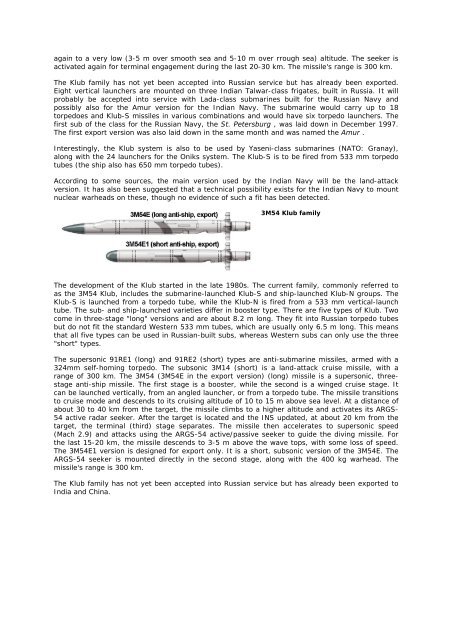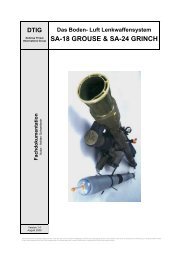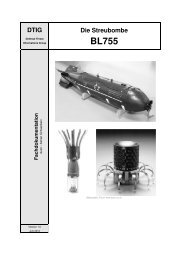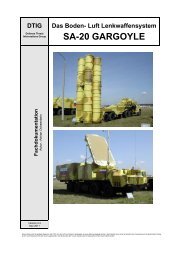RUSSIAN/SOVIET SEA-BASED ANTI-SHIP MISSILES Specia ... - DTIG
RUSSIAN/SOVIET SEA-BASED ANTI-SHIP MISSILES Specia ... - DTIG
RUSSIAN/SOVIET SEA-BASED ANTI-SHIP MISSILES Specia ... - DTIG
Create successful ePaper yourself
Turn your PDF publications into a flip-book with our unique Google optimized e-Paper software.
again to a very low (3-5 m over smooth sea and 5-10 m over rrough sea) altitude. The seeker is<br />
activated again for terminal engagement during the last 20-30 km. The missile's range is 300 km.<br />
The Klub family has not yet been accepted into Russian service but has already been exported.<br />
Eight vertical launchers are mounted on three Indian Talwar-class frigates, built in Russia. It will<br />
probably be accepted into service with Lada-class submarines built for the Russian Navy and<br />
possibly also for the Amur version for the Indian Navy. The submarine would carry up to 18<br />
torpedoes and Klub-S missiles in various combinations and would have six torpedo launchers. The<br />
first sub of the class for the Russian Navy, the St. Petersburg , was laid down in December 1997.<br />
The first export version was also laid down in the same month and was named the Amur .<br />
Interestingly, the Klub system is also to be used by Yaseni-class submarines (NATO: Granay),<br />
along with the 24 launchers for the Oniks system. The Klub-S is to be fired from 533 mm torpedo<br />
tubes (the ship also has 650 mm torpedo tubes).<br />
According to some sources, the main version used by the Indian Navy will be the land-attack<br />
version. It has also been suggested that a technical possibility exists for the Indian Navy to mount<br />
nuclear warheads on these, though no evidence of such a fit has been detected.<br />
3M54 Klub family<br />
The development of the Klub started in the late 1980s. The current family, commonly referred to<br />
as the 3M54 Klub, includes the submarine-launched Klub-S and ship-launched Klub-N groups. The<br />
Klub-S is launched from a torpedo tube, while the Klub-N is fired from a 533 mm vertical-launch<br />
tube. The sub- and ship-launched varieties differ in booster type. There are five types of Klub. Two<br />
come in three-stage "long" versions and are about 8.2 m long. They fit into Russian torpedo tubes<br />
but do not fit the standard Western 533 mm tubes, which are usually only 6.5 m long. This means<br />
that all five types can be used in Russian-built subs, whereas Western subs can only use the three<br />
"short" types.<br />
The supersonic 91RE1 (long) and 91RE2 (short) types are anti-submarine missiles, armed with a<br />
324mm self-homing torpedo. The subsonic 3M14 (short) is a land-attack cruise missile, with a<br />
range of 300 km. The 3M54 (3M54E in the export version) (long) missile is a supersonic, threestage<br />
anti-ship missile. The first stage is a booster, while the second is a winged cruise stage. It<br />
can be launched vertically, from an angled launcher, or from a torpedo tube. The missile transitions<br />
to cruise mode and descends to its cruising altitude of 10 to 15 m above sea level. At a distance of<br />
about 30 to 40 km from the target, the missile climbs to a higher altitude and activates its ARGS-<br />
54 active radar seeker. After the target is located and the INS updated, at about 20 km from the<br />
target, the terminal (third) stage separates. The missile then accelerates to supersonic speed<br />
(Mach 2.9) and attacks using the ARGS-54 active/passive seeker to guide the diving missile. For<br />
the last 15-20 km, the missile descends to 3-5 m above the wave tops, with some loss of speed.<br />
The 3M54E1 version is designed for export only. It is a short, subsonic version of the 3M54E. The<br />
ARGS-54 seeker is mounted directly in the second stage, along with the 400 kg warhead. The<br />
missile's range is 300 km.<br />
The Klub family has not yet been accepted into Russian service but has already been exported to<br />
India and China.











